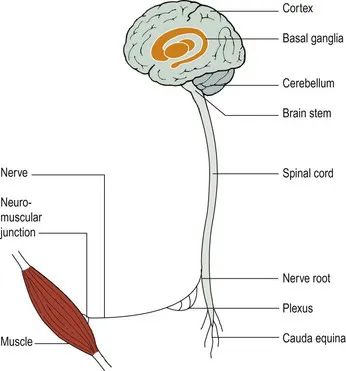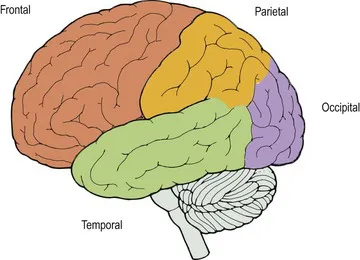
eBook - ePub
Neurology E-Book
An Illustrated Colour Text
Geraint Fuller, Mark R. Manford
This is a test
Compartir libro
- 144 páginas
- English
- ePUB (apto para móviles)
- Disponible en iOS y Android
eBook - ePub
Neurology E-Book
An Illustrated Colour Text
Geraint Fuller, Mark R. Manford
Detalles del libro
Vista previa del libro
Índice
Citas
Información del libro
An introductory textbook of neurology in the Illustrated Colour Text series, making full use of all the usual features of the series - double page spreads, short paragraphs, summary boxes, attractive use of colour etc.
- Clear explanation of neurological examination - often found very taxing by students.
- Demonstrates how to approach common neurological presentations, such as blackouts and numbness, before moving on to a comprehensive coverage of syndromes and diseases.
- Concentrates on the core curriculum which the medical student really needs to know.
- Updated management in the light of new evidence and new drugs most notably in Parkinson's disease, epilepsy and multiple sclerosis.
- Images, particularly MRI scans, updated with more modern and higher resolution images.
- Includes a new double-page spread on Sleep.
- Extra material added on giddiness to include the head thrust test and Epley's manoeuvre.
Preguntas frecuentes
¿Cómo cancelo mi suscripción?
¿Cómo descargo los libros?
Por el momento, todos nuestros libros ePub adaptables a dispositivos móviles se pueden descargar a través de la aplicación. La mayor parte de nuestros PDF también se puede descargar y ya estamos trabajando para que el resto también sea descargable. Obtén más información aquí.
¿En qué se diferencian los planes de precios?
Ambos planes te permiten acceder por completo a la biblioteca y a todas las funciones de Perlego. Las únicas diferencias son el precio y el período de suscripción: con el plan anual ahorrarás en torno a un 30 % en comparación con 12 meses de un plan mensual.
¿Qué es Perlego?
Somos un servicio de suscripción de libros de texto en línea que te permite acceder a toda una biblioteca en línea por menos de lo que cuesta un libro al mes. Con más de un millón de libros sobre más de 1000 categorías, ¡tenemos todo lo que necesitas! Obtén más información aquí.
¿Perlego ofrece la función de texto a voz?
Busca el símbolo de lectura en voz alta en tu próximo libro para ver si puedes escucharlo. La herramienta de lectura en voz alta lee el texto en voz alta por ti, resaltando el texto a medida que se lee. Puedes pausarla, acelerarla y ralentizarla. Obtén más información aquí.
¿Es Neurology E-Book un PDF/ePUB en línea?
Sí, puedes acceder a Neurology E-Book de Geraint Fuller, Mark R. Manford en formato PDF o ePUB, así como a otros libros populares de Medicine y Internal Medicine & Diagnosis. Tenemos más de un millón de libros disponibles en nuestro catálogo para que explores.
Información
Organization of the nervous system
The practice of clinical neurology depends on an appreciation of the structure and function of the nervous system. However, a detailed knowledge of neuroanatomy is not essential. This section will outline some of the important neuroanatomy needed for clinical neurology. Some areas, for example the anatomy of the visual system, will be described in the relevant section.
The levels of the nervous system
The nervous system is very complicated, in terms of both its structure and its physiology. Fortunately, when things go wrong they can be categorized on the basis of a relatively simple scheme of neuroanatomy. The nervous system can be thought of as having different levels (Fig. 1). The distribution and type of the clinical problem will often point to the affected level. For example, a patient who is confused must have a disturbance affecting the cerebral hemispheres. There are some situations when the level cannot immediately be determined: for example, a patient with foot drop could have a problem in the peripheral nerve, nerve root, spinal cord or cerebral hemisphere. Terminology used to describe disturbances at different levels is given in Box 1.

Fig. 1 Levels of the nervous system.
Box 1 Terminology
Abnormalities in the different levels of the nervous system can be referred to according to different terms. One commonly used system is described here. The suffix -opathy can be replaced by -itis if there is thought to be an inflammatory basis to the disturbance.










These terms can be combined with one another or other qualifiers to produce descriptions such as focal encephalopathy, or meningoencephalomyelitis (inflammation of the meninges, brain and spinal cord).
The central nervous system
The cerebral hemispheres
The cerebral hemispheres contain the apparatus of higher function. The dominant hemisphere (left in right-handed people) controls speech and the non-dominant hemisphere provides more spatial awareness. Different lobes undertake different functions (Fig. 2):





Fig. 2 Lobes of the brain.
The basal ganglia
The basal ganglia are interconnected deep nuclei including the putamen, caudate, globus pallidum and substantia nigra with complicated interrelations. They are involved in the integration of motor and sensory ...